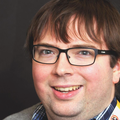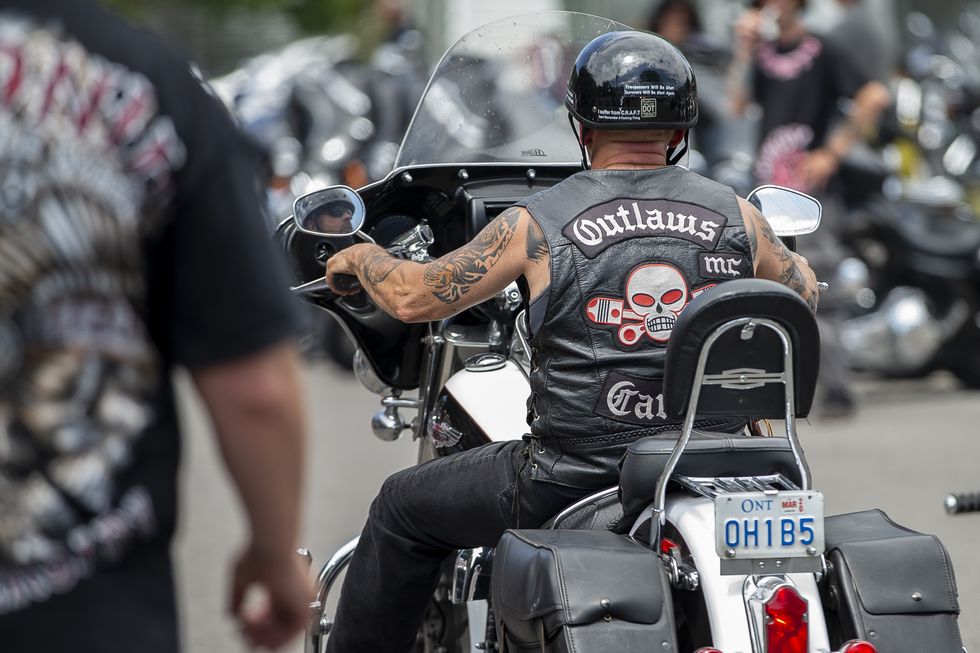In 1963, young motorcycle enthusiast Danny Lyon set out to “record and glorify the life of the American biker.” More than 60 years later, his striking photographs documenting the Chicago Outlaws motorcycle club are getting a contemporary makeover for the big screen.
Theatrical run on June 21 Bikers—starring Tom Hardy, Austin Butler, Jodie Comer and Mike Faist, tells the story of the Chicago Vandals, a fictionalized version of the Outlaws and some of their current members. Inspired by the famous 1968 Lyon photo book of the same name, the film examines the Vandals and their transition from a refuge for outcast bikers to something more sinister.
Similar to their on-screen counterparts, the Outlaws’ influence and reputation have changed dramatically since their inception.
Get tickets to The Bikeriders
The Outlaws were born almost 90 years ago
While Bikers documents the founding and rise of the fictional Vandals beginning in the 1960s, the real story of the Outlaws began three decades earlier. According to its official website, the club began as the McCook Outlaws Motorcycle Club in 1935. Bikers formed the group outside of Matilda’s Bar in McCook, Illinois, a suburb of Chicago. After years of limited inactivity during World War II, the organization held its first major rally at Chicago’s Soldier Field in 1946.
According to Time, the war was a major catalyst for the rise of motorcycle culture in the United States. The resulting military surplus made bicycles affordable, and returning veterans sought an adventurous escape from the tedium of civilian life. This led to the formation of other clubs, including the Hells Angels, the Outlaws’ main rival, in Fontana, California in 1948.
Meanwhile, the Outlaws continued to attract riders from throughout the Windy City and moved their headquarters from McCook in 1950 to become the Chicago Outlaws. Around this time, the club adopted its iconic skull logo on shirts and jackets; cross pistons were added four years later.
By 1964, the Outlaws had incorporated chapters from Milwaukee and Louisville, Kentucky, and attracted the interest of a young rider named Danny Lyon.
Lyon became a member of the Outlaws to create his book
Lyon was a freshman history major at the University of Chicago in 1959 when a classmate introduced him to motorcycle culture. Owner of a Triumph TR6 motorcycle, he will soon combine this new passion with his budding journalistic talents.
But Lyon first left Chicago in 1962 to document the civil rights movement. He served as official photographer for the Student Nonviolent Coordinating Committee and became friends with key figures such as John Lewis and Julian Bond.
A year later, he launched into his motorcycle project which would become Bikers. Although Lyon said he received a very distinct transformation in the new film – Faist, who plays his fictional replacement “Danny”, does not ride a motorcycle on screen – the photographer became a full member of the Outlaws in 1965 A self-described “pothead” in this primarily beer-drinking club, he documented his fellow members through photographs and analog recordings.
Published in 1968, Bikers the book was acclaimed and is said to have inspired the 1969 film EasyRider with Dennis Hopper, Peter Fonda and Jack Nicholson. However, Lyon left the group and the biker lifestyle following its release. “I loved my job and what I did, but it was a topic for me,” Lyon said. A rabbit’s foot“So when I thought I had what I needed, I knew it was time to move on, and I did.”
Real recordings from Lyon are used in the film
Bikers The film draws heavily on Lyon’s sources, including using “textual imitations” of his audio recordings, according to Bleak Beauty. Lyon spoke with Outlaws members Cal, Zipco and Cockroach, all of whom appear in the new film. The recreation treatment is particularly true for Comer’s character Kathy, modeled on the real Kathy Bauer, whose interviews form the narrative structure of the plot surrounding the fictional Vandals.
In 1966, the 25-year-old Bauer provided insight into the tight-knit nature of the Outlaws by describing his first encounter with a horseman named Benny (played by Butler). She detailed how the group, including frontman Johnny Davis (Hardy), tricked Bauer into taking a ride on Benny’s motorcycle. “He takes off, he goes through the red lights and everything so I don’t jump,” Bauer said in Lyon. “And I wouldn’t have jumped anyway because I was less afraid; I had never ridden a motorcycle in my entire life.
“Johnny was really nice to me. He said, “Don’t worry, I’m the president of this club and I wouldn’t let anything happen to you.” They’re just having fun, and this guy wanted to date you,'” Bauer said. This unusual courtship worked out when Bauer and Benny later married. Their relationship is highlighted in the film.
But while this cordiality is exemplified through the Outlaws’ on-screen stand-ins, the club has been linked to much more antagonistic activity in the decades since.
Today’s Outlaws are quite different from the movie
The Outlaws have spread far beyond their Chicago hub in the decades since, with the organization now boasting chapters in at least 26 states and reaching countries like France, Ireland, Japan and Russia. According to Chicago Readerthe Outlaws had more than 1,500 members in 2014.
However, the club developed a treacherous reputation. Since November 2023, the U.S. Department of Justice has classified the Outlaws as one of 300 “outlaw motorcycle gangs” or OMGs. These are described as “highly structured criminal organizations whose members engage in criminal activities such as violent crime, arms trafficking and drug trafficking.”
Much of this comes from the group’s ongoing feud with the Hells Angels. THE Chicago Sun-Times reported that the two factions waged a violent turf war in the city during the 1990s – including a series of bombings, shootings and stabbings – before reaching an uneasy truce. According to TwinCities.com, the Outlaws use the coded acronym ADIOS, which stands for “Angels Die in Outlaw States.”
In an interview given in November 2016 to Sun times, a former Outlaws member named Peter James said the Hells Angels’ presence in the Chicago area has become more influential and could spark more conflict. However, he suggested that modern outlaws have moved away from crime and violence. ” The times have changed. Somehow there’s no testosterone,” James said. “In the past, the boss’s word was the law. He said, “Get off the cliff,” and the guys were coming off a cliff. The quality of members has declined.
Regardless, most riders argued that the club was simply adopting an alternative lifestyle and was not an organized crime syndicate.
See Bikers in theaters June 21
Director Jeff Nichols said Bikers is not intended to be a documentary about the Chicago Outlaws, nor to show disrespect to the club in any way. He simply hopes to give viewers a sense of the times and societal conditions that allowed the group to thrive.
“When you watch these guys, if you want, you can just dismiss them, but if you watch the film, you start to see how their brains work, and hopefully you start to identify with them a little bit,” he said A rabbit’s foot. “Feeling out of place is something everyone feels. This should be a unifying trait.
The film hits theaters Friday and stars Tom Hardy as Johnny, Austin Butler as Benny, Jodie Comer as Kathy and Mike Faist as Danny.
Get tickets

Tyler Piccotti first joined the Biography.com staff as deputy editor in February 2023, and before that he worked almost eight years as a journalist and editor-in-chief. He graduated from Syracuse University. When he’s not writing or researching his next story, you can find him at the nearest amusement park, watching the latest movie, or cheering on his favorite sports teams.
